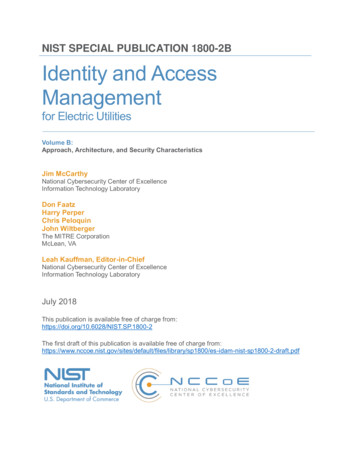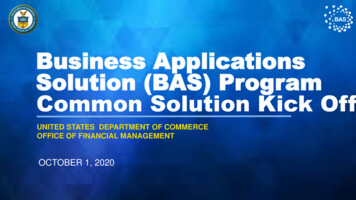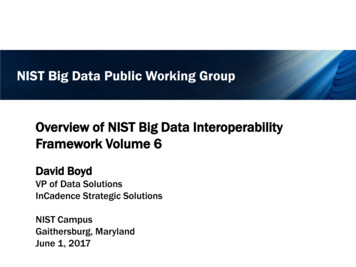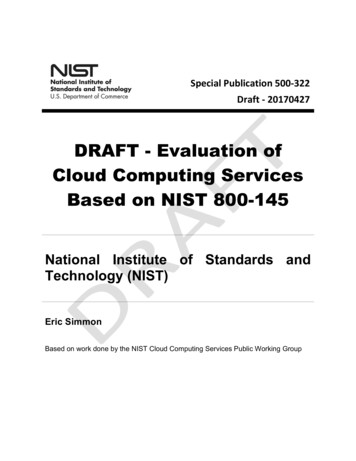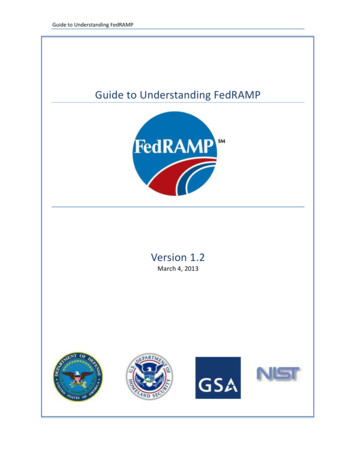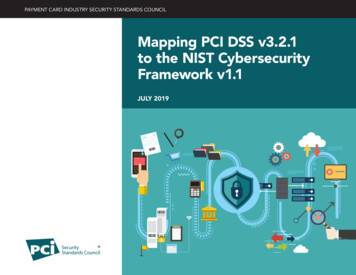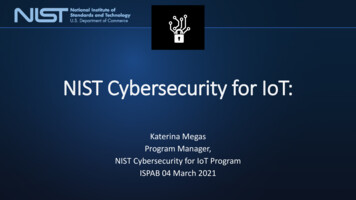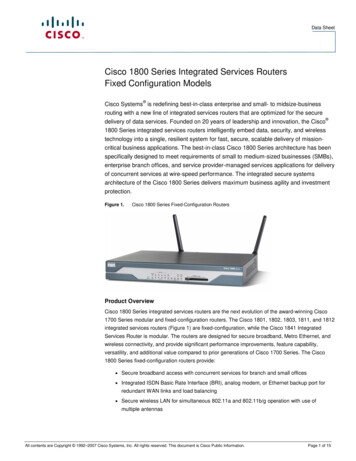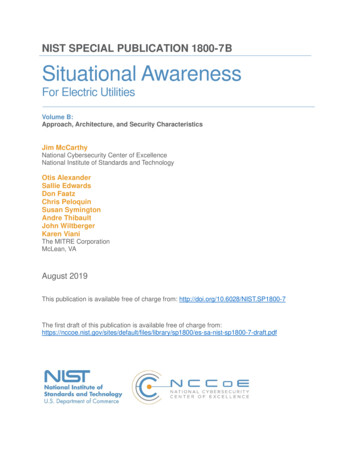
Transcription
NIST SPECIAL PUBLICATION 1800-7BSituational AwarenessFor Electric UtilitiesVolume B:Approach, Architecture, and Security CharacteristicsJim McCarthyNational Cybersecurity Center of ExcellenceNational Institute of Standards and TechnologyOtis AlexanderSallie EdwardsDon FaatzChris PeloquinSusan SymingtonAndre ThibaultJohn WiltbergerKaren VianiThe MITRE CorporationMcLean, VAAugust 2019This publication is available free of charge from: http://doi.org/10.6028/NIST.SP1800-7The first draft of this publication is available free of charge brary/sp1800/es-sa-nist-sp1800-7-draft.pdf
DISCLAIMERCertain commercial entities, equipment, products, or materials may be identified in this document inorder to describe an experimental procedure or concept adequately. Such identification is not intendedto imply recommendation or endorsement by NIST or NCCoE, nor is it intended to imply that theentities, equipment, products, or materials are necessarily the best available for the purpose.National Institute of Standards and Technology Special Publication 1800-7B, Natl. Inst. Stand. Technol.Spec. Publ. 1800-7B, 86 pages, (August 2019), CODEN: NSPUE2FEEDBACKAs a private-public partnership, we are always seeking feedback on our Practice Guides. We areparticularly interested in seeing how businesses apply NCCoE reference designs in the real world. If youhave implemented the reference design, or have questions about applying it in your environment,please email us at energy nccoe@nist.gov.All comments are subject to release under the Freedom of Information Act (FOIA).National Cybersecurity Center of ExcellenceNational Institute of Standards and Technology100 Bureau DriveMailstop 2002Gaithersburg, MD 20899Email: nccoe@nist.govNIST SP 1800-7B: Situational Awareness for Electric Utilitiesi
NATIONAL CYBERSECURITY CENTER OF EXCELLENCEThe National Cybersecurity Center of Excellence (NCCoE), a part of the National Institute of Standardsand Technology (NIST), is a collaborative hub where industry organizations, government agencies, andacademic institutions work together to address businesses’ most pressing cybersecurity issues. Thispublic-private partnership enables the creation of practical cybersecurity solutions for specificindustries, as well as for broad, cross-sector technology challenges. Through consortia underCooperative Research and Development Agreements (CRADAs), including technology partners — fromFortune 50 market leaders to smaller companies specializing in IT security — the NCCoE appliesstandards and best practices to develop modular, easily adaptable example cybersecurity solutions usingcommercially available technology. The NCCoE documents these example solutions in the NIST SpecialPublication 1800 series, which maps capabilities to the NIST Cybersecurity Framework and details thesteps needed for another entity to recreate the example solution. The NCCoE was established in 2012 byNIST in partnership with the State of Maryland and Montgomery County, Md.To learn more about the NCCoE, visit https://www.nccoe.nist.gov/. To learn more about NIST, visithttps://www.nist.gov.NIST CYBERSECURITY PRACTICE GUIDESNIST Cybersecurity Practice Guides (Special Publication Series 1800) target specific cybersecuritychallenges in the public and private sectors. They are practical, user-friendly guides that facilitate theadoption of standards-based approaches to cybersecurity. They show members of the informationsecurity community how to implement example solutions that help them align more easily with relevantstandards and best practices and provide users with the materials lists, configuration files, and otherinformation they need to implement a similar approach.The documents in this series describe example implementations of cybersecurity practices thatbusinesses and other organizations may voluntarily adopt. These documents do not describe regulationsor mandatory practices, nor do they carry statutory authority.ABSTRACTThrough direct dialogue between NCCoE staff and members of the energy sector (composed mainly ofelectric power companies and those who provide equipment and/or services to them) it became clearthat energy companies need to create and maintain a high level of visibility into their operatingenvironments to ensure the security of their operational resources (operational technology [OT]),including industrial control systems (ICS), buildings, and plant equipment. However, energy companies,as well as all other utilities with similar infrastructure and situational awareness challenges, also needinsight into their corporate or information technology (IT) systems and physical access control systems(PACS). The convergence of data across these three often self-contained silos (OT, IT, and PACS) canbetter protect power generation, transmission, and distribution.Real-time or near real-time situational awareness is a key element in ensuring this visibility across allresources. Situational awareness, as defined in this use case, is the ability to comprehensively identifyand correlate anomalous conditions pertaining to ICS, IT resources, and access to buildings, facilities,and other business mission-essential resources. For energy companies, having mechanisms to capture,NIST SP 1800-7B: Situational Awareness for Electric Utilitiesii
transmit, view, analyze, and store real-time or near-real-time data from ICS and related networkingequipment provides energy companies with the information needed to deter, identify, respond to, andmitigate cyber attacks against their assets.With such mechanisms in place, electric utility owners and operators can more readily detect anomalousconditions, take appropriate actions to remedy them, investigate the chain of events that led to theanomalies, and share findings with other energy companies. Obtaining real-time and near-real-time datafrom networks also has the benefit of helping demonstrate compliance with information securitystandards. This NCCoE project’s goal is ultimately to improve the security of OT through situationalawareness.This NIST Cybersecurity Practice Guide describes our collaborative efforts with technology providers andenergy sector stakeholders to address the security challenges that energy providers face in deploying acomprehensive situational awareness capability. It offers a technical approach to meeting the challengeand also incorporates a business value mind-set by identifying the strategic considerations involved inimplementing new technologies. The guide provides a modular, end-to-end example solution that canbe tailored and implemented by energy providers of varying sizes and sophistication. It shows energyproviders how we met the challenge by using open-source and commercially available tools andtechnologies that are consistent with cybersecurity standards. The use case is based on an everydaybusiness operational scenario that provides the underlying impetus for the functionality presented inthe guide. Test cases were defined with industry participation to provide multiple examples of thecapabilities necessary to provide situational awareness.While the example solution was demonstrated with a certain suite of products, the guide does notendorse these products. Instead, it presents the characteristics and capabilities that an organizationʼssecurity experts can use to identify similar standards-based products that can be integrated quickly andcost effectively with an energy provider’s existing tools and infrastructure.KEYWORDScorrelated events; cybersecurity; energy sector; information technology; operational technology; physicalaccess control systems; security information and event management; situational awarenessNIST SP 1800-7B: Situational Awareness for Electric Utilitiesiii
ACKNOWLEDGMENTSWe are grateful to the following individuals for their generous contributions of expertise and time.NameOrganizationRobert LeeDragosJustin CavineeDragosJon LavenderDragosSteve RobertsHewlett Packard EnterpriseBruce OehlerHewlett Packard EnterpriseGil KroyzerICS2Gregory RavikovichICS2Robert BellICS2Fred HintermeisterNERCPaul J. GeraciOSIsoftMark McCoyOSIsoftStephen J. SarneckiOSIsoftPaul StrasserPPCMatt McDonaldPPCSteve SagePPCT.J. RoeRadiflowAyal VogelRadiflowNIST SP 1800-7B: Situational Awareness for Electric Utilitiesiv
NameOrganizationDario LobozzoRadiflowDave BarnardRS2Ben SmithRSATarik WilliamsRSA, a Dell Technologies businessDavid PerodinRSA, a Dell Technologies businessGeorge WrennSchneider ElectricMichael PyleSchneider ElectricAJ NicolosiSiemensJeff FoleySiemensBill JohnsonTDi TechnologiesPam JohnsonTDiClyde PooleTDiEric ChapmanUniversity of Maryland, College ParkDavid S. ShaughnessyUniversity of Maryland, College ParkDon HillUniversity of Maryland, College ParkMary-Ann IbeziakoUniversity of Maryland, College ParkDamian GriffeUniversity of Maryland, College ParkMark AlexanderUniversity of Maryland, College ParkNollaig HeffernanWaratekNIST SP 1800-7B: Situational Awareness for Electric Utilitiesv
NameOrganizationJames LeeWaratekJohn Matthew HoltWaratekAndrew GinterWaterfallCourtney SchneiderWaterfallTim PierceWaterfallKori FiskThe MITRE CorporationTania CopperThe MITRE CorporationNIST SP 1800-7B: Situational Awareness for Electric Utilitiesvi
The Technology Partners/Collaborators who participated in this build submitted their capabilities inresponse to a notice in the Federal Register. Respondents with relevant capabilities or productcomponents were invited to sign a Cooperative Research and Development Agreement (CRADA) withNIST, allowing them to participate in a consortium to build this example solution. We worked with:Technology Partner/CollaboratorBuild InvolvementDragosCyberLensHewlett Packard Enterprise*ArcSightICS2OnGuardOSIsoftPi HistorianRadiflowiSIMRS2 TechnologiesAccess It!, Door ControllerRSA, a Dell Technologies businessArcher Security Operations ManagementSchneider ElectricTofino FirewallSiemensRUGGEDCOM CROSSBOWTDi TechnologiesConsoleWorksWaratekWaratek Runtime Application ProtectionWaterfall Security SolutionsUnidirectional Security Gateway, Secure Bypass*Please note: Hewlett Packard Enterprise in this project is now Micro Focus Government Solutions, whichacquired the suite of products and solutions used by the NCCoE in this build.The NCCoE also wishes to acknowledge the special contributions of the University of Maryland forproviding us with a real-world setting for the situational awareness build; Project Performance Companyfor its dedication in assisting the NCCoE with the very challenging and complex integration in this build;and the NCCoE Energy Provider Community for its patience, support, and guidance throughout the lifecycle of this project.NIST SP 1800-7B: Situational Awareness for Electric Utilitiesvii
Contents3.3.1Security .83.3.2Existing Infrastructure.83.3.3Technical Implementation .93.3.4Capability Variation.93.4.1Assessing Risk Posture .93.4.2Security Control Map .114.2.1Example Solution Monitoring and Data Collection Lab Build .294.2.2Example Solution Data Aggregation and Analysis Lab Build .324.3.1Example Solution Operations Remote Management Lab Build .35NIST SP 1800-7B: Situational Awareness for Electric Utilitiesviii
4.3.2Example Solution Enterprise Remote Management Lab Build .365.1.1Cybersecurity Framework Subcategories that Are Supported .455.2.1Protecting the ICS Network .615.2.2Protecting the Reference Design from Outside Attack.625.2.3Protecting the Remote Management Paths .635.2.4Protecting the Remote Path to the IDS Web Interface .665.2.5Protecting the SIEM .66NIST SP 1800-7B: Situational Awareness for Electric Utilitiesix
List of FiguresFigure 4-1 High-Level Example Solution Architecture.26Figure 4-2 Network Connections Color Code .27Figure 4-3 Monitoring, Data Collection, and Analysis Example Solution .28Figure 4-4 Operations Monitoring and Data Collection Lab Build Architecture .31Figure 4-5 Enterprise Data Aggregation and Analysis Lab Build Architecture .33Figure 4-6 Remote Management Example Solution .34Figure 4-7 Operations Remote Management Lab Build Architecture .35Figure 4-8 Enterprise Remote Management Lab Build Architecture .36Figure 5-1 Monitoring/Data Collection Subarchitecture Depicted with Generic Component Names . 38Figure 5-2 Data Aggregation/Analysis Subarchitecture Using Generic Component Names . 39Figure 5-3 Monitoring/Data Collection Management Architecture Depicted Using Generic ComponentNames .54NIST SP 1800-7B: Situational Awareness for Electric Utilitiesx
List of TablesTable 3-1 Security Characteristics and Controls Mapping – NIST Cybersecurity Framework . 11Table 3-2 Products and Technologies .14Table 3-3 Situational Awareness Test Cases .19Table 5-1 SA Reference Design Components and the Cybersecurity Framework Subcategories thatThey Support .40Table 5-2 Components for Managing and Securing the SA Reference Design and Protecting the ICSNetwork .55Table 6-1 Functional Test Plan .73Table 6-2 Functional Evaluation Requirements.74Table 6-3 Test Case ID: SA-1.75Table 6-4 Test Case ID: SA-2.77Table 6-5 Test Case ID: SA-3.78Table 6-6 Test Case ID: SA-4.79Table 6-7 Test Case ID: SA-5.81Table 6-8 Test Case ID: SA-6.82NIST SP 1800-7B: Situational Awareness for Electric Utilitiesxi
1 SummarySituational awareness (SA) is “the perception of elements in the environment within a volume of timeand space, the comprehension of their meaning, and the projection of their status in the near future”[1]. The intent of SA is to know what is happening around you and how it might affect your activities. Forelectricity utilities, this means understanding what is happening in the environment that might affectdelivery of electricity to customers. Traditionally, this has involved knowing the operating status ofgeneration, transmission, and distribution systems, as well as physical challenges such as weather andreadiness, to facilitate response to outages. As computers and networks have been incorporated in gridoperations, awareness of the cyber situation is becoming increasingly important to ensuring that “thelights stay on.”The National Cybersecurity Center of Excellence (NCCoE) met with energy sector stakeholders tounderstand key cybersecurity issues impacting operations. The feedback emphasized a more efficientmeans of comprehensively detecting potential cybersecurity incidents directed at their operationaltechnology (OT) or industrial control systems (ICS), information technology (IT) or corporate networks,and their physical facilities such as substations and corporate offices.The NCCoE’s example solution provides a converged and correlated view of OT, IT, and physical accessresources. In our reference design, we collect sensor data from these resources and provide alerts to aplatform that produces actionable information.This example solution is packaged as a “how to” guide that demonstrates how to implement standardsbased cybersecurity technologies in the real world based on risk analysis and regulatory requirements.The guide might help the energy industry gain efficiencies in SA while saving research and proof-ofconcept costs.1.1 The ChallengeEnergy companies rely on OT to control the generation, transmission, and distribution of power. Whilethere are a number of useful products on the market for monitoring enterprise networks for possiblesecurity events, these products tend to be imperfect fits for the unusual requirements of control systemnetworks. ICS and IT devices were designed with different purposes in mind. Attempting to use ITsecurity applications for ICS, although in many cases useful, still does not properly account for theavailability requirements of ICS networks. A network monitoring solution that is tailored to the needs ofcontrol systems would reduce security blind spots and provide real-time SA, that is, provide notificationof events as they occur.To improve overall SA, energy companies need mechanisms to capture, transmit, view, analyze, andstore real-time or near-real-time data from ICS and related networking equipment. With suchmechanisms in place, electric utility owners and operators can more readily detect anomalousNIST SP 1800-7B: Situational Awareness for Electric Utilities1
conditions, take appropriate actions to remedy them, investigate the chain of events that led to theanomalies, and share findings with other energy companies. Obtaining real-time or near-real-time datafrom networks also helps organizations be compliance with information security standards orregulations, particularly those that require specific event log information.There is a definite need to improve a utility’s ability to detect cyber-related security breaches oranomalous behavior, in real or near real time. The ability to do this will result in earlier detection ofcybersecurity incidents and potentially reduce the severity of the impact of these incidents within autility’s operational infrastructure. Energy sector stakeholders noted that a robust situational awarenesssolution also must be able to alert for both individual and correlated events or incidents. To addressthese needs, we created a scenario in which a technician dispatcher notices that a substation relay hastripped and begins to investigate the cause. The technician uses a single software interface thatmonitors system buses, displays an outage map, correlates operational network connections to the busand outage maps, and indexes operational network and physical security device logs. The technicianbegins the investigation by querying network logs to determine whether any ICS devices receivedcommands that might have caused the trip. If the answer is yes, then, using the same interface, thetechnician can automatically examine logs of the most recent commands and network traffic sent to therelevant devices. This information allows the technician to effectively extend the investigation tointernal systems and users who communicated with the suspect devices.To extend the scenario, an analyst on the IT network receives notification that a server is down. Theanalyst investigates across the network and is alerted of the tripped substation relay. Are the anomaliesconnected? Use of our SA solution could answer this question in addition to achieving the needsdescribed above. Additional benefits of the solution are addressed in Section 1.4.1.2 The SolutionThis NIST Cybersecurity Practice Guide demonstrates how commercially available technologies can meeta utility’s need to provide comprehensive real-time or near-real-time SA.The NCCoE laboratory houses an environment that simulates the common devices and technologiesfound in a utility such as IT and OT systems and physical access control systems (PACS). In this guide, weshow how a utility can implement a converged alerting capability to provide a comprehensive view ofcyber-related events and activities across silos by using multiple commercially available products.Furthermore, we identified products and capabilities that, when linked together, provide a convergedand comprehensive platform that can alert utilities to potentially malicious activity.The guide provides: a detailed example solution and capabilities that address security controls a demonstration of the approach that uses commercially available productsNIST SP 1800-7B: Situational Awareness for Electric Utilities2
how-to instructions for implementers and security engineers with instructions on integratingand configuring the example solution into their organization’s enterprise in a manner thatachieves security goals with minimal impact on operational efficiency and expenseCommercial, standards-based products such as the ones we used are readily available and interoperablewith existing IT infrastructure and investments. Our simulated environment is similar in breadth anddiversity to the distributed networks of large organizations, which can include corporate and regionalbusiness offices, power generation plants, and substations, but not on the same scale of deployed assetsas these large organizations.This guide lists all the necessary components and provides installation, configuration, and integrationinformation so that an energy company can replicate what we have built. The NCCoE does not endorsethe suite of commercial products used in the reference design. These products were utilized after anopen call to participate via the Federal Register. A utility’s security expert(s) should identify thestandards-based products that will best integrate with the existing tools and systems already containedin the ICS and IT infrastructure. A business can adopt this solution or one that adheres to theseguidelines in whole, or this guide can be used as a starting point for tailoring and implementing parts ofa solution.1.3 RisksThis practice guide addresses risk by using current industry standards, such as North American ElectricReliability Corporation Critical Infrastructure Protection (NERC CIP) V5, as well as taking into account riskconsiderations at both the operational and strategic levels.At the strategic level, one might consider the cost of mitigating these risks and the potential return oninvestment in implementing a product (or multiple products). One might also want to assess if aconverged SA platform can help enhance the productivity of employees, minimize impacts to theoperating environment, and provide the ability to investigate incidents to mitigate future occurrences.This example solution addresses imminent operational security risks and incorporates strategic riskconsiderations.Operationally, the lack of a converged SA platform, especially one with the ability to collect andcorrelate sensor data from all the silos, can increase both the risk of malicious cyber attacks beingdirected at an organization, or worse, the resulting damage that might ensue should such attacks goundetected. At a fundamental level, SA provides alerts to potential malicious behavior, which includesdetection, prevention, and reporting mechanisms to ensure that proper remediation and investigationtake place should these events occur.Adopting any new technology, including this example SA solution, can introduce new risks to anenterprise. However, by aggregating sensor data from all the silos (OT, PACS, and IT), a utility canincrease its ability to identify a potentially malicious event that might otherwise go undetected orNIST SP 1800-7B: Situational Awareness for Electric Utilities3
unreported. The lack of ability to see across the silos and correlate event data yields a potential blindspot to the safe and secure operation of utilities’ most critical business assets.1.4 BenefitsThe NCCoE, in collaboration with our stakeholders in the energy sector, identified the need for anetwork monitoring solution specifically adapted to include ICS cybersecurity. The following are whatwe determined to be the key (but not exclusive) benefits of implementing this solution: improves a utility’s ability to detect cyber-related security breaches or anomalous behavior,likely resulting in earlier detection and less impact of critical incidents on energy delivery,thereby lowering overall business risk increases the probability that investigations of attacks or anomalous system behavior will reachsuccessful conclusions improves accountability and traceability, leading to valuable operational lessons learned simplifies regulatory compliance by automating generation and collection of a variety ofoperational log data2 How to Use This GuideThis NIST Cybersecurity Practice Guide demonstrates a standards-based reference design and providesusers with the information they need to replicate the example solution. This reference design is modularand can be deployed in whole or in part.This guide contains three volumes: NIST SP 1800-7A: Executive Summary NIST SP 1800-7B: Approach, Architecture, and Security Characteristics – what we built and why(you are here) NIST SP 1800-7C: How-To Guides – instructions for building the example solutionDepending on your role in your organization, you might use this guide in different ways:Business decision makers, including chief security and technology officers, will be interested in theExecutive Summary (NIST SP 1800-7A), which describes the following topics: challenges that sector organizations face in maintaining cross-silo situational awareness example solution built at the NCCoE benefits of adopting the example solutionNIST SP 1800-7B: Situational Awareness for Electric Utilities4
Technology or security program managers who are concerned with how to identify, understand, assess,and mitigate risk will be interested in this part of the guide, NIST SP 1800-7B, which describes what wedid and why. The following sections will be of particular interest: Section 3.4.1, Assessing Risk Posture, provides a description of the risk analysis we performed Section 3.4.2, Security Control Map, maps the security characteristics of this example solution tocybersecurity standards and best practicesYou might share the Executive Summary, NIST SP 1800-7A, with your leadership team members to helpthem understand the importance of adopting standards-based SA for electric utilities.IT professionals who want to implement an approach like this will find the whole practice guide useful.You can use the How-To portion of the guide, NIST SP 1800-7C, to replicate all or parts of the buildcreated in our lab. The How-To guide provides specific product installation, configuration, andintegration instructions for implementing the example solution. We do not recreate the productmanufacturers’ documentation, which is generally widely available. Rather, we show how weincorporated the products together in our environment to create an example solution.This guide assumes that IT professionals have experience implementing security products within theenterprise. While we have used a suite of commercial products to address this challenge, this guide doesnot endorse these particular products. Your organization can adopt this solution or one that adheres tothese guidelines in whole, or you can use this guide as a starting point for tailoring and implementingparts of a solution that includes PACS and OT and IT systems, and business processes. Yourorganization’s security experts should identify the products that will best integrate with your existingtools and IT system infrastructure. We hope you will seek products that are congruent with applicablestandards and best practices. Section 3.5, Technologies, lists the products we used and maps them tothe cybersecurity controls provided by this reference solution.2.1 Typographic ConventionsThe following table presents typographic conventions used in this volume.Typeface/SymbolItalicsMeaningExampleFile names and path names;references to documents thatare not hyperlinks; new terms;and placeholdersFor detailed definitions of terms, seethe NCCoE Glossary.NIST SP 1800-7B: Situational Aw
challenges in the public and private sectors. They are practical, user-friendly guides that facilitate the adoption of standards -based approaches to cybersecurity. They show members of the information security community how to implement example
